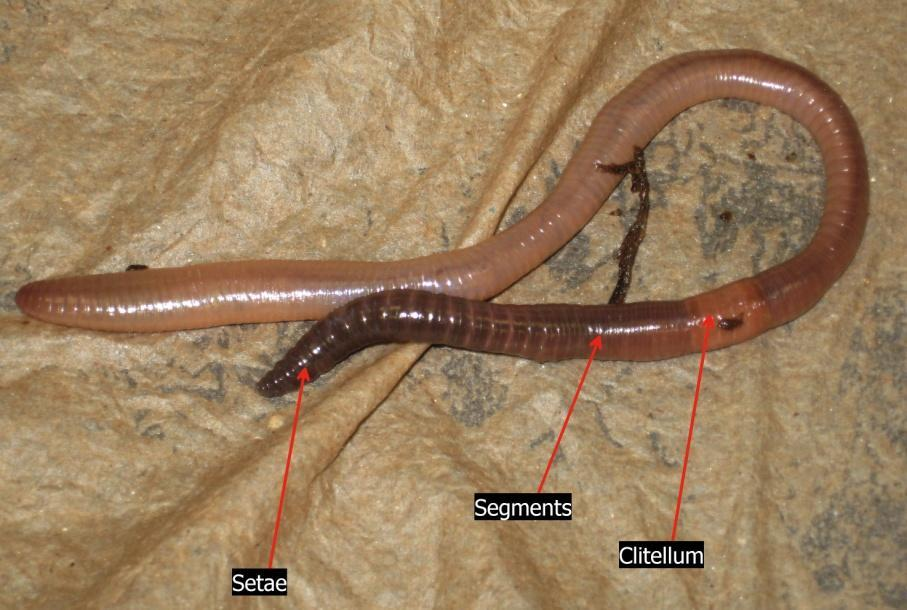
In earthworms setae are present in all segments except
A. First and the last segment
B. First and the clitellum
C. First segment
D. Clitellum and last segment
E. First, clitellum and last segment
Answer
461.4k+ views
Hint: We have to remember that an earthworm is an invertebrate of the earth which belongs to the order Opisthopora. They exhibit a body plan of tube-within-a-tube, are segmented externally with sufficient internal segmentation, and typically have setae on all segments. As we know that the soil, water, and temperature allow, they occur worldwide.
Complete answer:
We have to remember that the segmentation can help move the earthworm. There are muscles and bristles called setae in each segment or part. The clitellum has a thickened glandular and which is present in the non-sectioned part of the body wall close to the head of earthworms and leeches that emits a viscid case in which eggs are stored. It is situated between the fourteenth and seventeenth segments near the anterior side of the body.
A clitellum, which is a modification of a portion of the body wall consisting of a glandular, saddle-like thickening near the gonopores, has sexually mature oligochaetes. With the exception of the first, last and clitular segments, Setae are the 'S' shaped stiff bristles present on the complete earthworm body. These seats serve a significant role in locomotion.
So, the correct answer is “Option E”.

Note: We have to know that the bristles or setae, when moving via the dirt, help anchor and control the worm. The bristles keep tightly into the ground a segment of the worm, while the other area of the body protrudes forward. To allow the body to elongate in one area or contract in other areas, the earthworm utilizes segments to either contract or relax independently. In its movement, segmentation allows the worm to be versatile and solid. If, without being separate, each segment shifted together the earthworm would be stationary.
Complete answer:
We have to remember that the segmentation can help move the earthworm. There are muscles and bristles called setae in each segment or part. The clitellum has a thickened glandular and which is present in the non-sectioned part of the body wall close to the head of earthworms and leeches that emits a viscid case in which eggs are stored. It is situated between the fourteenth and seventeenth segments near the anterior side of the body.
A clitellum, which is a modification of a portion of the body wall consisting of a glandular, saddle-like thickening near the gonopores, has sexually mature oligochaetes. With the exception of the first, last and clitular segments, Setae are the 'S' shaped stiff bristles present on the complete earthworm body. These seats serve a significant role in locomotion.
So, the correct answer is “Option E”.

Note: We have to know that the bristles or setae, when moving via the dirt, help anchor and control the worm. The bristles keep tightly into the ground a segment of the worm, while the other area of the body protrudes forward. To allow the body to elongate in one area or contract in other areas, the earthworm utilizes segments to either contract or relax independently. In its movement, segmentation allows the worm to be versatile and solid. If, without being separate, each segment shifted together the earthworm would be stationary.
Recently Updated Pages
Glucose when reduced with HI and red Phosphorus gives class 11 chemistry CBSE

The highest possible oxidation states of Uranium and class 11 chemistry CBSE

Find the value of x if the mode of the following data class 11 maths CBSE

Which of the following can be used in the Friedel Crafts class 11 chemistry CBSE

A sphere of mass 40 kg is attracted by a second sphere class 11 physics CBSE

Statement I Reactivity of aluminium decreases when class 11 chemistry CBSE

Trending doubts
10 examples of friction in our daily life

Difference Between Prokaryotic Cells and Eukaryotic Cells

One Metric ton is equal to kg A 10000 B 1000 C 100 class 11 physics CBSE

State and prove Bernoullis theorem class 11 physics CBSE

What organs are located on the left side of your body class 11 biology CBSE

Define least count of vernier callipers How do you class 11 physics CBSE




